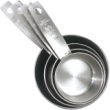Tips to help you avoid overfeeding your pet
Overweight pet? Try some free and
easy tips for weight loss
MetPet.com Staff Writer
Studies show that over-eating in humans is caused by a number of
factors that have nothing to do with appetite. Since we have total
control over what, when and how much our pets eat - or at least what they
have in their bowl - this research into human eating behavior may help us
get our dogs, cats and other pets back into their slim, trim and healthy
figures.
Bland and Boring Make the Grade
Variety in foods increases our appetite. If we pile on a variety of
different tastes, textures and types of food onto our plate at each meal, we
will tend to eat more overall. A wide variety of pleasant tasting
foods can increase our intake at a single meal by almost 50%.
Apparently our reaction to variety has to do with the way we experience
pleasure from eating. If we eat a single food until we are full, our
sense of pleasure from eating that food and similar foods is reduced.
If we introduce another type of food that is significantly different, our
delight in eating returns. We need to skip the buffet and stick to a
single taste sensation per meal.
In order to better control your pet's appetite, stick to a single,
complete food and remove all treats while your pet is losing weight.
This is usually more of an issue with dogs than with other pets since dogs
usually inhale everything organic in sight.
If you feed your paunchy pooch a single, high-quality kibble, you can
also use the same kibble for the mid-afternoon snack. Just reduce the
amount of kibble during the meal. Your dog may lose some interest in
food, seeing the same kibble over and over again, and may find other avenues
of interest such as playing and walking.
If you're using food treats for training, the same kibble can be used for
this purpose as well. Just remember to pour the kibble into the bowl
first and them remove a handful to use for treats.
Measure the Quantity
While doling out food, it's easy to resort to eye-balling the quantity.
With food like kibble, it's easy to grab some kibble in a scoop and pour it
into the bowl without much concern for the actual quantity.
  A
metal measuring cup with a long handle makes a great scoop. It's easy
to fill and clean and tough enough to scoop kibble without breaking.
Start off by placing the regular amount of kibble or soft food into your
pet's bowl. Place that amount into the measuring cup. A
metal measuring cup with a long handle makes a great scoop. It's easy
to fill and clean and tough enough to scoop kibble without breaking.
Start off by placing the regular amount of kibble or soft food into your
pet's bowl. Place that amount into the measuring cup.
Reduce that amount by 10% for a week. See if this makes a
noticeable difference in your pet's appearance and energy. Reduce it
by another 10% for another week and keep reducing it slowly until you begin
to see weight loss. Fast weight loss in humans and pets leads to loss
of muscle mass instead of fat so a slow, deliberate reduction in calories
and an increase in calorie burning is the healthiest way to go.
Use a Smaller Bowl
When humans eat on smaller plates, say an 8 inch salad plate instead of a 10
inch dinner plate, we tend to eat less. Perhaps we're affected by the
sense of abundance, or lack thereof, when we see a heaping plate.
Pets probably don't care that much about how full their bowl is --
probably -- but humans probably do. A smaller bowl may help us place
less food on our pet's plate without feelings of guilt.
|

 No other toy will do. When I ask her to find
WiggleLegs she goes right to it! I just ordered 3 more as I'm afraid
you will stop making them and then I don't know what we will do!"
No other toy will do. When I ask her to find
WiggleLegs she goes right to it! I just ordered 3 more as I'm afraid
you will stop making them and then I don't know what we will do!"


